Manufacturing Reform: Female Convicts and Straw Bonnets
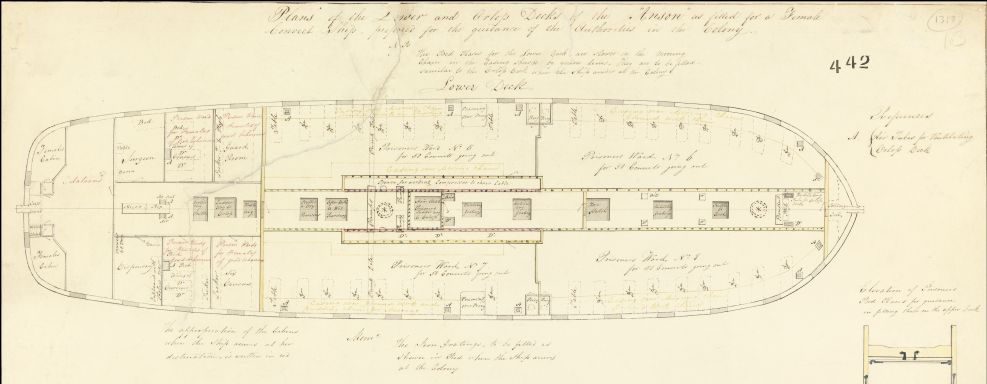
This blog is one of a series that explores in greater depth some of the fascinating stories that we uncovered while researching Duck Trousers, Straw Bonnets, and Bluey: Stories of fabrics and clothing in Tasmania, an exhibition currently on display in the State Library of Tasmania and Tasmanian Archives Reading Room in Hobart. These blogs are designed to complement the exhibition, expanding some elements of the exhibition story walls to provide more context and different perspectives.
The convict era is one often characterised by stories of harsh punishments and brutality. It is a period remembered for its chain gangs, solitary confinement, hard labour, and infamous lashings of the cat-o’-nine-tails. While this experience was true for many convicts housed in female factories, prisons, and penitentiaries throughout Van Diemen’s Land between 1803 and 1853, when transportation formally ceased, it was not the experience of all. There were exceptions to the rule.
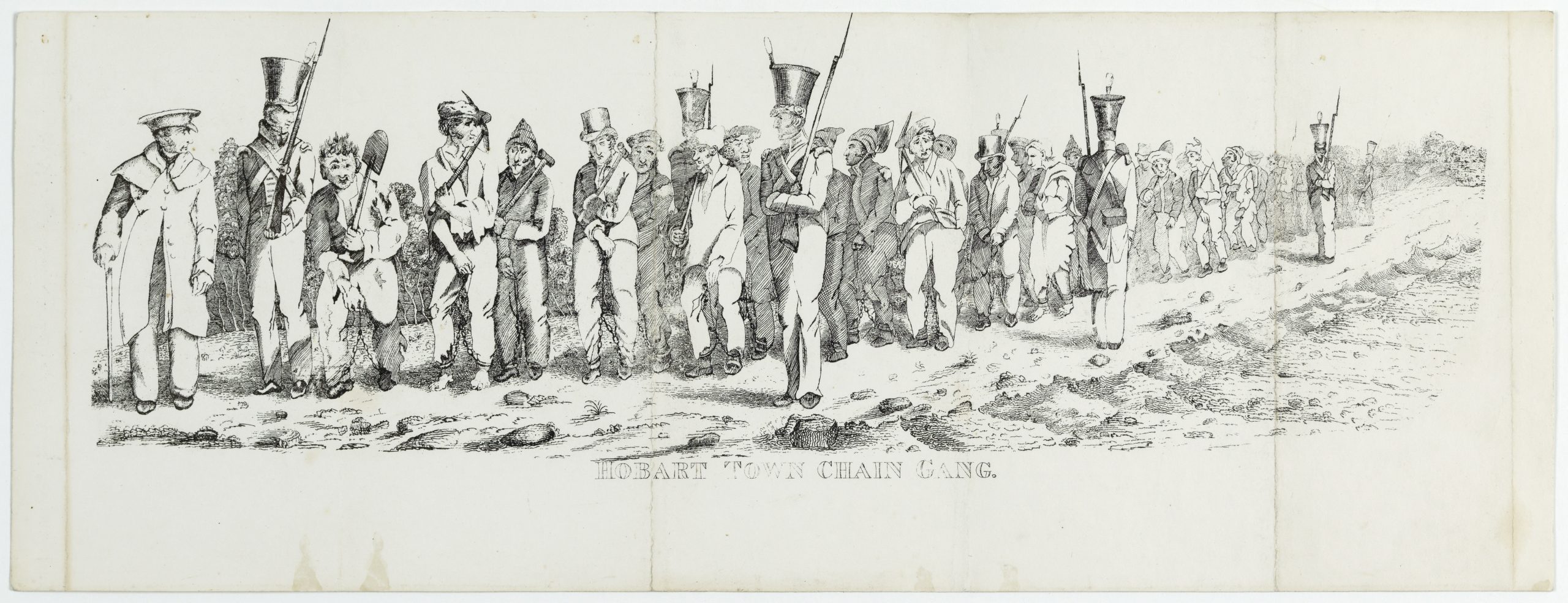
One such exception was the Anson Probation Station located on the Derwent River at Prince of Wales Bay. When considering the history and stories that surround this warship-turned-probation-station, one is overwhelmed by images of female convicts working side by side in various manufactories, making woollen garments, straw bonnets, and their own clothing. It presents a story of female reform, ingenuity and arguably, progress that the colonial world was not yet prepared for.
The HMS Anson and Probation
From 1844 to 1849, over 4,000 of the total 12,500 female convicts transported to Van Diemen’s Land undertook a period of probation aboard the HMS Anson, a former warship and male convict transport ship (Schaffer, The Anson, n.d.). Under the initial superintendence of Dr Edmund Bowden and his wife, the Matron, Mrs Phillipa Bowden, the Anson held between 250 and 519 female convicts at any given time for the duration of six months (Williams, “The Archaeological Potential”, 2005, p. 80).
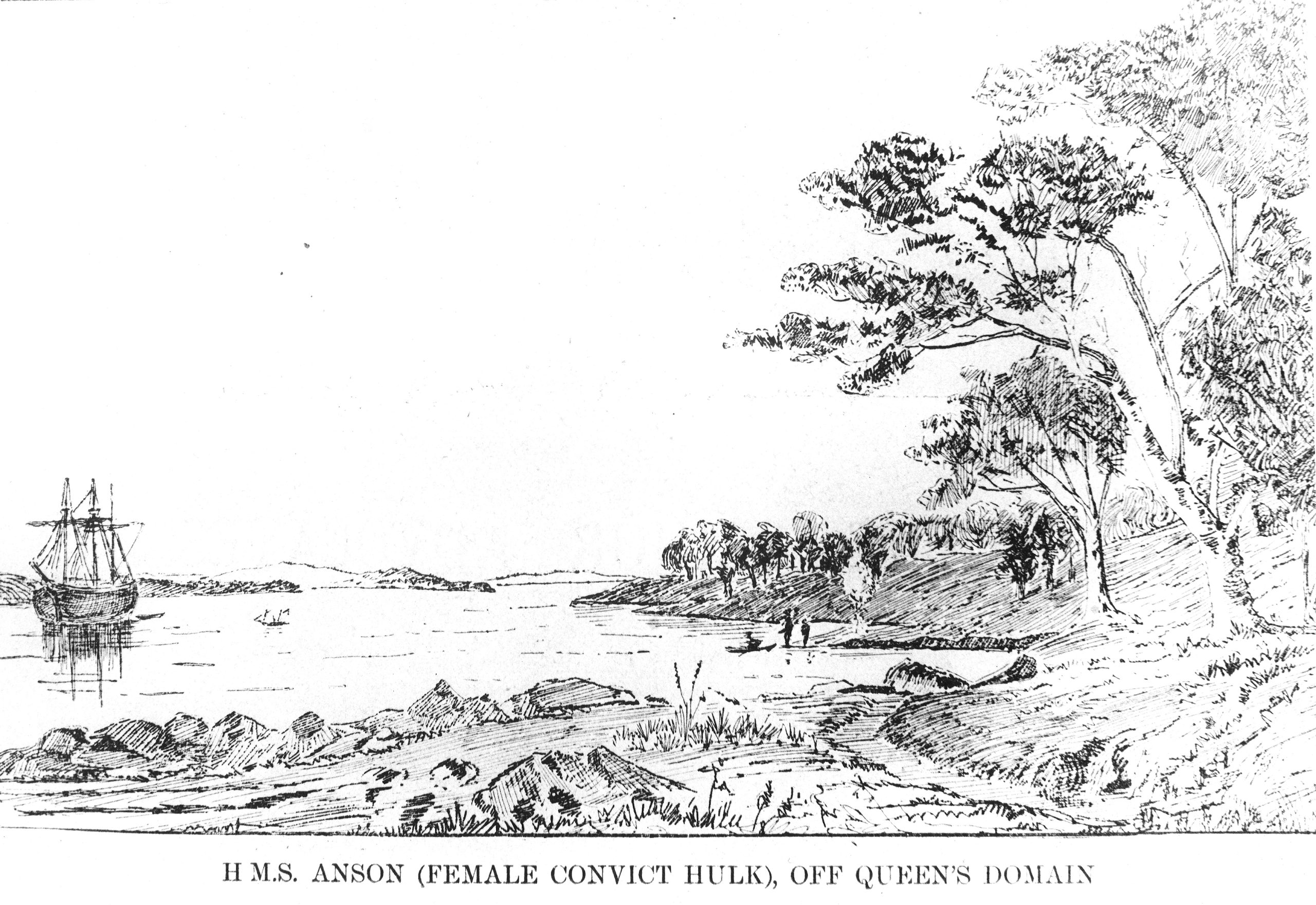
The Anson was an experiment of the probation period following the convict system’s transition from the assignment period in 1839. It was the intention of colonial figureheads, such as Lord Stanley, to reform prisoners through several stages of punishment that decreased in severity overtime. Despite this, there was no single or agreed upon method for how such reform should take place (Sprod, Probation System, 2005). In one instance, the surgeon superintendent of Pentonville Penitentiary, Dr John S Hampton, believed the best instrument of female reformation was marriage (Brand, The Convict Probation System, 1990, p. 94). It can be argued that the reformative practices established on board the Anson were in direct opposition of such a view.
The Evolution of an Idea
It was the initial expectation of the Anson convicts to undertake a daily routine of “early rising, sweeping, cleaning, sewing and scripture reading” (Kavanagh, et. el., Van Diemen’s Women, 2015, p. 133), however, Mrs Bowden sought more substantial employment for her prisoners. She did so by venturing into the world of manufacturing. Mrs Bowden took steps towards such by having the convicts make their own attire:
All the clothes for the female convicts were sent out from England ready-made, and thus […] there were no means of giving prisoners employment, even by the manufacture of the very clothes they wear. [.. Mrs Bowden applied] to the government at home to have the unmade materials sent out, so that she might give them to the convicts to cut out and make their own wearing apparel.
The Cornwall Chronicle, Sept 8, 1847, p.4.
It was reported in the Hobart Town Gazette that female convicts were provided items including a cotton or stuff gown, or petticoat, and a jacket and apron, which were likely all made of “cheap and coarse materials” (Oct. 10, 1829, p. 4). It is likely then, that the Anson convicts made at least some of these items upon Mrs Bowden’s instruction.
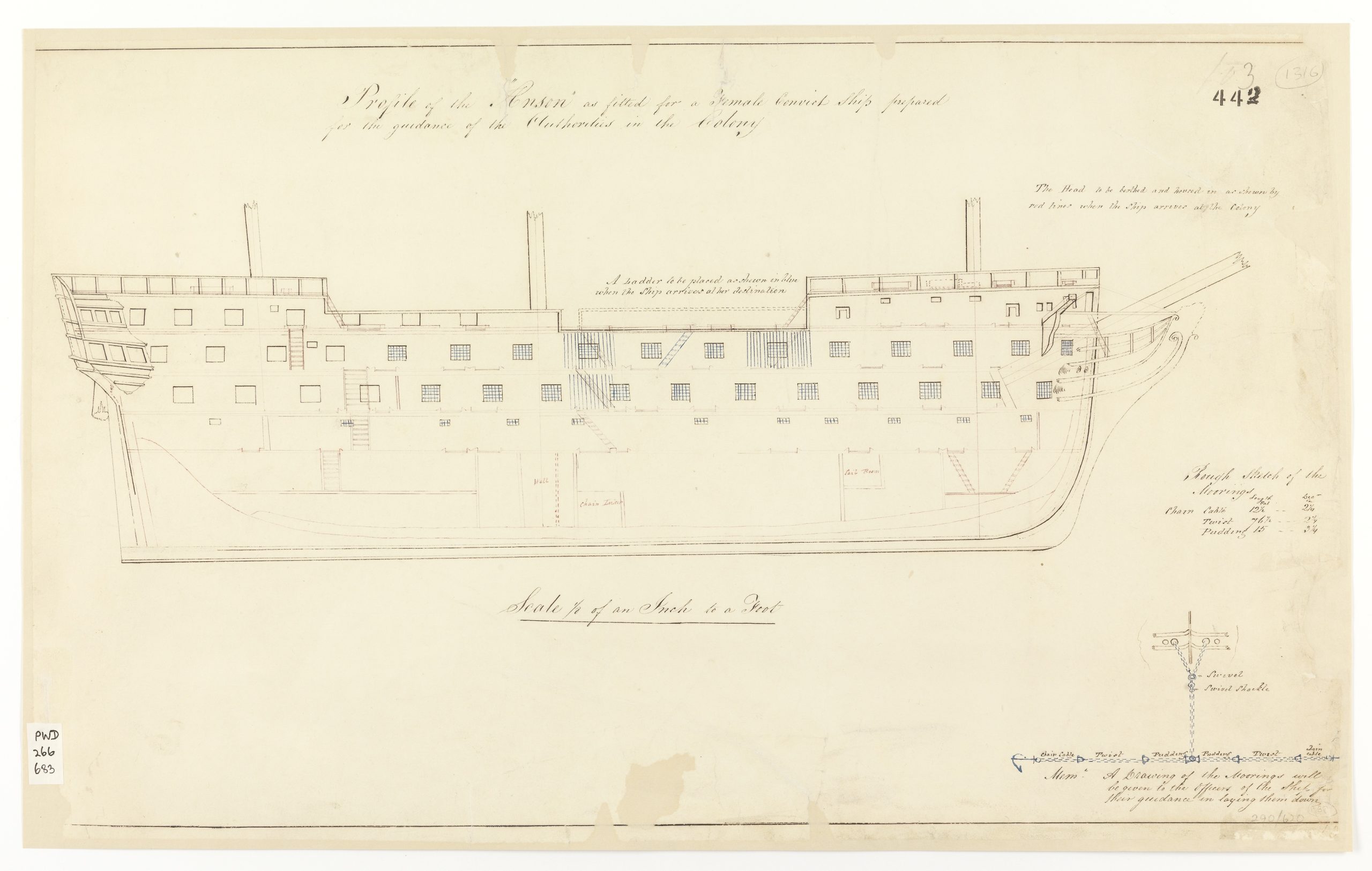
Mrs Bowden’s manufacturing endeavours had varying degrees of success. While a plan to make and sell shirts did not achieve its intended outcomes, there is evidence to suggest processes of wool manufacture were carried out onboard. As reported in the Launceston Examiner:
Employment is found for others in this establishment, in the manufacture of stockings from wool, the whole process of which in washing, carding, spinning, knitting, and dying, is completed on board.
Launceston Examiner, Nov. 16, 1850, p.5.
Woollen items such as “hose for women” were made and sent out to ordinance stores for sale. It is not surprising, after her success, that Mrs Bowden strove to install an industry that was yet to be established in Hobart Town – straw bonnet manufacturing.
A Bonnet Manufactory on the Derwent
The bonnet was a fashionable accessory for women in England throughout the 19th Century and the design changed and adapted to suit the fashions and hairstyles of the time. In the early years of the 1800s, for instance, the Poke Bonnet was “all the rage” (Amphlett, Hats, 2003, p. 132), while the version of the 1820s became exaggerated to accommodate higher hairstyles. This continued into the 1830s in which the bonnet took its most lavish and extreme form (Black and Garland, A History of Fashion, 1975, p.185). By 1836, the bonnet began to shrink, and a funnel shape characterised those of the 1840s. According to a 1904 article published in The Queenslander, by 1846 “a very demure style of bonnet was worn” (April 16, 1904, p.7). The article continues:
The brim and crown were continuous, and it set flat on the head. The edge of the crown was adorned with a wreath of flowers, and the only trimming of the flat part consisted of parallel bands of ribbon or velvet. There was very little space under the brim, and no cap front was worn. The cap front was dispersed with because it would have eclipsed the beauty of the hairdressing which was visible under the bonnet in sausage shaped rolls on either side of the face.
The Queenslander, April 16, 1904, p.7.
It is unlikely that such finishings of flowers and velvet adorned the bonnets made by the convict women aboard the Anson, however, it is known that they were made of straw. It was also confirmed by the Hobart Town Advertiser that the bonnets were made in the “stylish polka” and “pretty cottage” styles (Sept. 14, 1847, p.4).
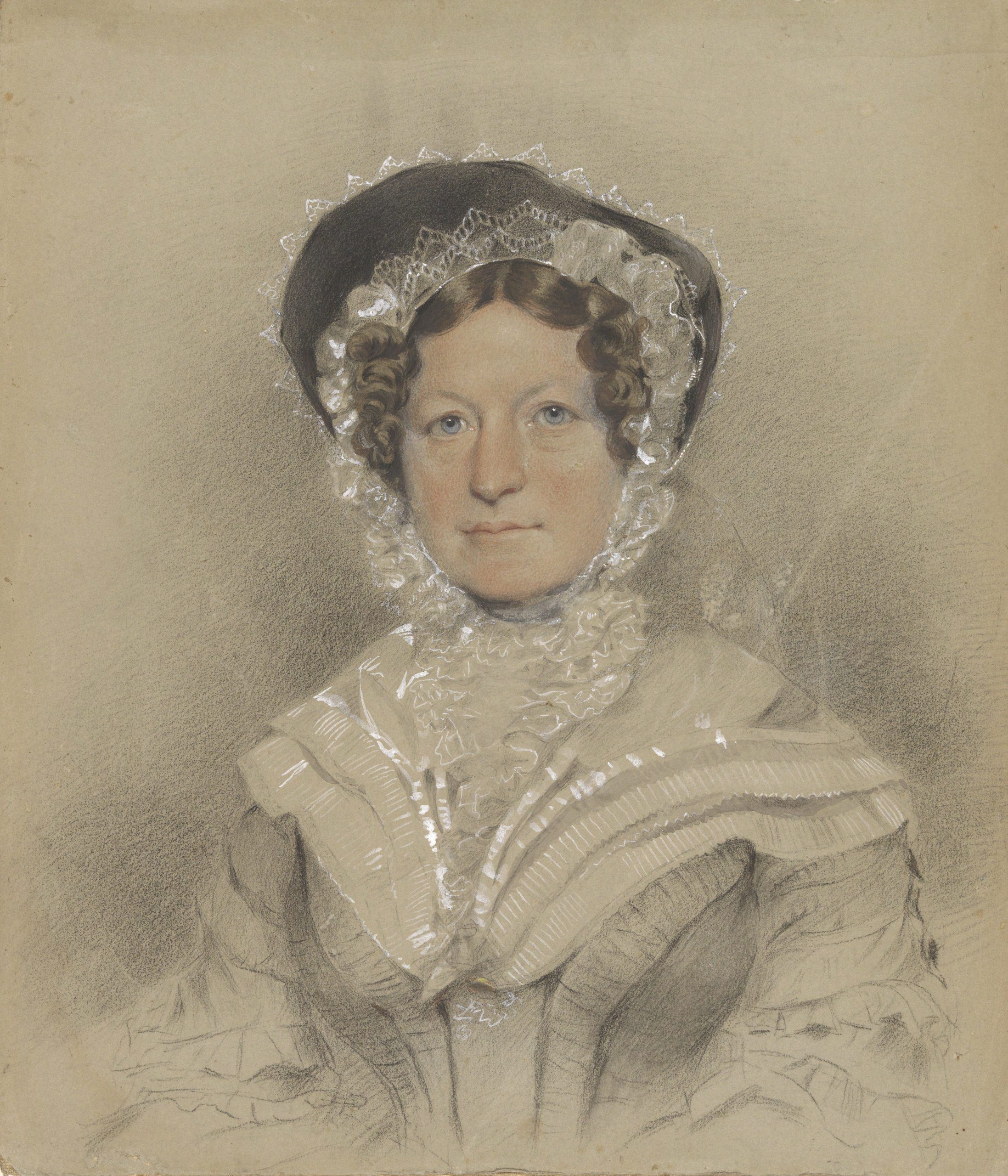

There were several established bonnet shops in Hobart Town during this time, although none had the necessary machinery to manufacture their own bonnets (The Cornwall Chronicle, Sept. 18, 1847, p. 4). To many this would have posed an obstacle, but to Mrs Bowden, it was an opportunity for innovation. Mrs Bowden recounted such in 1850 when she noted that “some ingenious women on board [..] succeeded in making straw splitters out of beef bones; these were followed by other necessaries” (Launceston Examiner, p. 5). According to the Cornwall Chronicle, “Mrs. Bowden obtained some straw, and ere long had taught herself to make [a straw bonnet]” (Sept. 18, 1847, p.4). Having acquired the necessities for bonnet making, the Anson manufactory was established with 150 female convicts partaking in the operation while others contributed to the woollen manufacture (The Cornwall Chronicle, Sept. 18, 1847, p. 4).
A Formidable Woman at the Helm
Despite Mrs Bowden’s success in her role as Matron, and later sole superintendent following the death of her husband in 1847, the Anson Probation Station was not destined for longevity. In its time the Anson was regarded by some as an exception to the common view of Van Diemen’s Land and most notably it was regarded an “El Dorado” of the convict system:
Mrs Bowden has accomplished much indeed for the reformation of women. We do not wonder at the young woman wishing to make her escape from misery and starvation in England, to such an “El Dorado” as the Anson.
The Hobart Town Advertiser, Sept. 14, 1847
Despite this, many, even in hindsight, consider the Anson a failure alongside the probation system. Kay Daniels contends that the Anson was unfit for service and Mrs Bowden, upon returning to England, left Van Diemen’s Land without successfully implementing her plans for widespread reform (Convict Women, 1998, p. 128). This reflects the opinion of many in the press at the time who wrote of Mrs Bowden in critical, often patriarchal terms:
[Mrs Bowden] will look with despondency, if not despair, and turning to her husband will say, “I really wish we were back in England again.” Stop a little Mrs B., do not despair, we will take leave to give you a plan by which you will be able to reform these idle, silly creatures. Make them usefully industrious, and you effect your purpose; they will then become useful servants and complete the reformation by becoming industrious and happy wives and mothers.
Colonial Times, May 6, 1845, p. 2.
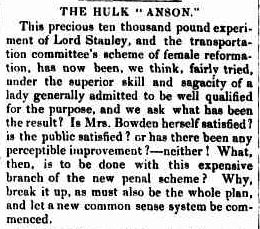
To say Mrs Bowden was unsuccessful does not recognise the feats of a woman in a patriarchal world as the above quote attests to. Patrick Howard, supports this, arguing that Mrs Bowden was the mainspring of penal reform, despite the odds that were against her (To Hell or to Hobart, 1993, p. 134). Furthermore, the progressiveness of the Anson Establishment is perhaps due to the assertion that Mrs Bowden saw the women on board as more than the crimes they had committed, more than “idle, silly creatures”. Her dedication to the cause of reform and employment indicates her recognition of their basic human rights, as did the provision of the basic dignity of a fashionable piece of headwear upon their leave. Mrs Bowden wrote in hindsight:
Until the introduction of straw bonnet making on board, nearly all the poor women were obliged to leave us for going to service without any bonnet. On representation to Sir E. Wilmot, they were permitted to be supplied with one.
Launceston Examiner, Nov. 16, 1850, p. 5.
Therefore, while some have argued that the probation period was “a disastrous failure” (Sprod, Probation System, 2005) it can be ascertained that Mrs Bowden and her establishment, with regard to female reformation and progress, were indeed an exception to the rule.
Bibliography
State Library Sources
Amphlett, H. (2003). Hats: A History of Fashion in Headwear. Dover Publications.
Anderson Black, J. and Garland, M. (1975). A History of Fashion. 2nd Ed. Rev. by Kennett, F. (1980). Orbis.
Brand, I. (1990). The Convict Probation System, Van Diemen’s Land 1839-1854: A Study of the Probation System of Convict Discipline. Blubber Head Press.
Daniels, K. (1998). Convict Women. Allen & Unwin.
Kavanagh, J., Snowden, D., and McAleese, M. (2015). Van Diemen’s Women: A History of Transportation to Tasmania. History Press.
Howard, P. (1993). To Hell or to Hobart: The Story of an Irish Convict Couple Transported to Tasmania in the 1840s. Kangaroo Press Pty. Ltd.
Archival Sources
Tasmanian Archives: Photograph – Lady in bonnet, pencil drawing. NS5198/1/27
Allport Library and Museum of Fine Arts, Tasmanian State Library: Woman in a black bonnet: possibly Mrs. Georgina Butler. [Between 1845 and 1855].
Tasmanian Archives: Plan-Ship, Anson-profile-as fitted out for a female convict ship-and mooring. Architect, Chatham Yard, U.K. (1843), PWD266/1/683.
Tasmanian Archives: Photograph – Sketch of H.M.S. Anson – female convict hulk – off Queen’s Domain. (n.d.). PH30/1/1980
W.L. Crowther Library, State Library and Archive Service: Hobart Town Chain Gang / Charles Bruce. Engraving, [between 1830-1831].
Newspaper Sources
Discipline at the Anson. (1847, September 14).The Hobart Town Advertiser (Tas.: 1839 – 1861), p. 4. Retrieved April 4, 2023, from http://nla.gov.au/nla.news-article264520302
Female Convicts in Van Diemen’s Land. (1847, September 18). The Cornwall Chronicle (Launceston, Tas.: 1835 – 1880), p. 4. Retrieved April 4, 2023, from http://nla.gov.au/nla.news-article65981778
Female Convicts. (1829, October 10). The Hobart Town Gazette (Tas.: 1825 – 1833), p. 4. Retrieved April 4, 2023, from http://nla.gov.au/nla.news-article264613715
The “Anson” Establishment. (1850, November 16). Launceston Examiner (Tas.: 1842 – 1899), p. 5. Retrieved April 4, 2023, from http://nla.gov.au/nla.news-article36267480
The History of the Bonnet. (1904, April 16). The Queenslander (Brisbane, Qld.: 1866 – 1939), p. 7. Retrieved April 19, 2023, from http://nla.gov.au/nla.news-article22263310
Journal Articles
Williams, B. (2005). “The Archaeological Potential of Colonial Prison Hulks: The Tasmanian case study”. The Journal of the Australasian Institute for Maritime Archaeology, 29, pp. 77-86.
Online Sources
Schaffer, I. (n.d.). The Anson – history of the ship. Retrieved April 19, 2023, from https://www.tasfamily.net.au/~schafferi/index.php?file=kop27.php
Sprod, M. (2005). Probation System, in The Companion to Tasmanian History, ed. Alison Alexander, Centre for Tasmanian Historical Studies, University of Tasmania, Accessed April 19, 2023, https://www.utas.edu.au/library/companion_to_tasmanian_history/P/Probation%20system.htm


Rewarding Bowden must have been a woman ahead of her time ,, it is heartening to learn some people had compassion for the convicts and to give them rewarding tasks. Many women could possibly spin,sew and knit so MrsBowden capitalised upon these skills. If the women could see their labours would be advantageous to them I imagine they would be willing workers Very interesting.